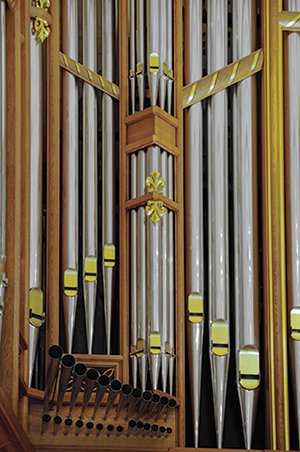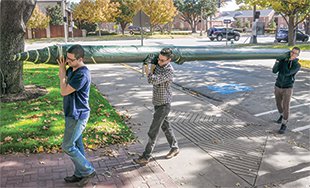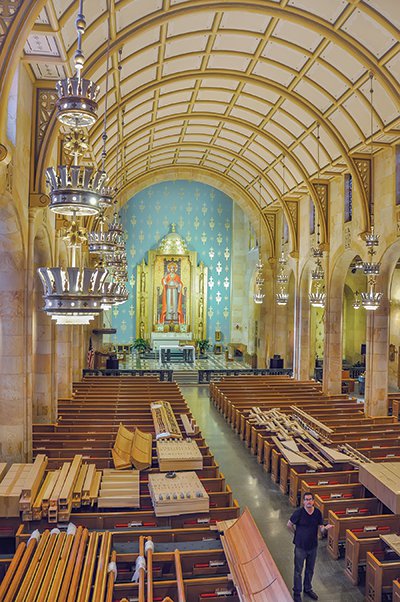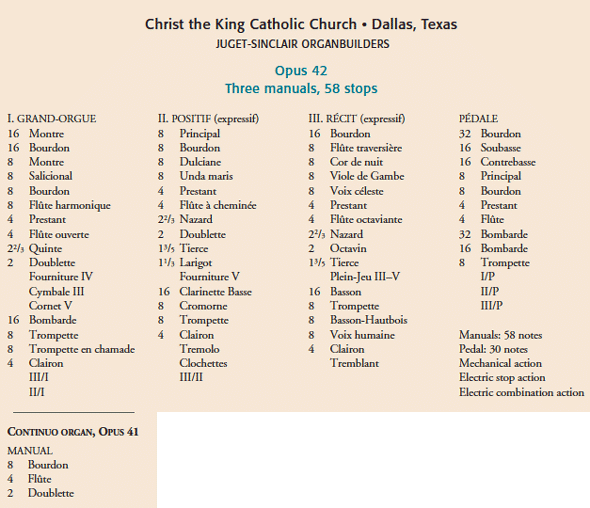Christ the King Catholic Church, Dallas, TX
Juget-Sinclair Organbuilders, Montreal, Quebec
By Stephen Sinclair
An organ project is, by its nature, a long process—it can be helpful for organbuilders to reflect on the beginning once we’ve reached the end. We might forget, for example, that the project at Christ the King in Dallas was, for all intents and purposes, dead in the water for more than a year, for lack of a solution to the conundrum of how to successfully build a mechanical-action instrument out-of-chambers, without placing any weight on the balcony itself, or reducing space for the choir.
 It wasn’t an aha moment that led us to a solution. It was more a case of the elimination of doubt—as crazy as it seemed, we could see no downside to our proposal: a three-manual, French-Romantic-inspired instrument, with Grand-Orgue and most of the Pédale division against the back wall, supported entirely by two beams that traverse the gallery. Both Récit and Positif would be in swell boxes occupying the chambers to each side, but cantilevered and angled into the room to promote projection. The console would be detached, with trackers running above the existing concrete choir risers, but below new oak risers. Trackers to all divisions would scale the three walls of the choir loft, taking practically no room from the choir. Our previous experience told us that we could
offer this solution happily—there would be no compromise in the success of the action, the projection of each division, choir seating, or access for maintenance. It just seemed so unusual that it required the methodical elimination of doubt for us to feel comfortable floating the proposal. If the instrument seems natural now, it didn’t then.
It wasn’t an aha moment that led us to a solution. It was more a case of the elimination of doubt—as crazy as it seemed, we could see no downside to our proposal: a three-manual, French-Romantic-inspired instrument, with Grand-Orgue and most of the Pédale division against the back wall, supported entirely by two beams that traverse the gallery. Both Récit and Positif would be in swell boxes occupying the chambers to each side, but cantilevered and angled into the room to promote projection. The console would be detached, with trackers running above the existing concrete choir risers, but below new oak risers. Trackers to all divisions would scale the three walls of the choir loft, taking practically no room from the choir. Our previous experience told us that we could
offer this solution happily—there would be no compromise in the success of the action, the projection of each division, choir seating, or access for maintenance. It just seemed so unusual that it required the methodical elimination of doubt for us to feel comfortable floating the proposal. If the instrument seems natural now, it didn’t then.
Christ the King organist Henry McDowell first contacted us about the project in 2006. Returning to his hometown of Winston-Salem, North Carolina, he had visited Jack Michener and played his two-stop Juget-Sinclair practice organ—and thus began his interest in our firm. (We’re tickled that our smallest instrument led to our largest!) Jesse Eschbach was brought on board as consultant, and his encyclopedic knowledge of 19th-century French organ stoplists has proven invaluable. Henry and Jesse came to Montreal, perhaps for the McGill summer organ academy; an instrument set up in the shop provided a catalyst for discussions around the console, and the project was born.
Although the chambers provide ample space for pipes, much of it was not useful, as our mandate was to build an organ that wouldn’t sound like it was in chambers. Initially, we were unable to find room for the large instrument proposed, or at least room in a position that had a chance of projecting well into the nave—only the 32′ Pédale octaves were allowed deep in the chambers. The solution was to modify the specification to make the Positif expressive as well, which gave a symmetrical arrangement with Récit to the left, and Positif to the right, each cantilevered into the room, and with the swell shades arranged to reflect sound toward the nave. The experience points out a truth in organ design: when space is tight, space will strongly influence design. It will have its say, and needs its place at the table.

The proposed steel structure provided an interesting challenge: the beams would sag an estimated 5/8″ under the full weight of the instrument—how would the casework accommodate this? Mechanical engineer Nigel Brown provided the answer. Given weight estimates of every part of the instrument and a drawing showing where that weight would bear down on the structure, he was able to tell us how much each beam would deflect. When the steel structure was set up, cables were anchored in the balcony floor and to the steel, then tightened until the beams had deflected according to calculations. Once the full weight of the upper organ, including pipework, was installed on the beams, we released the tension on the cables. The casework did not move perceptibly! The process necessitated an unusual installation order: everything above the beams first—upper casework, windchest, pipework, and wind system; then, once the cables were released, everything below the beams—lower casework, trackers, and risers.
Included in the project was a three-stop continuo organ intended to accompany small groups of singers or instruments in the transept, both during services and for concerts. There had also been a request for an antiphonal division of just three stops, whose sole purpose was to accompany the cantor at the pulpit during services. We suggested that perhaps the two roles could be combined, and so we set out to make the continuo playable from the Positif keyboard of the main console, via two possible plug-in spots in front. The system is more flexible than we had anticipated, and the balance between the two is good; the continuo organ is used as a sort of antiphonal during services, often accompanying one verse of a hymn to good effect.

This instrument is inspired by the French-Romantic tradition, but is by no means a copy. It borrows from the aesthetic, but through the lens of North American musical and liturgical requirements, and the cultural and acoustical context at Christ the King. Reeds are fiery but not overpowering. There is a surprising variety of color, and with two Swell boxes, a wide range of tonal possibilities. Windchests are largely installed at one height, favoring tuning stability. The Récit and Positif are arranged chromatically, with trebles at the front near the swell shades, which naturally promotes ascendancy of voicing.
This is a Juget-Sinclair organ, so the success of the tracker action is paramount. In order to provide ample wind without making the left hand too heavy, 8′ and 16′ flues are systematically winded electropneumatically. We came up with a design for pneumatic motors based on the 19th-century French “Schmoele et Mols” system, but using Reisner magnets. The motors are housed inside the pallet box, and are easily accessed, removed, and serviced. They open a secondary pallet beside the mechanical pallet, allowing wind into a secondary channel for basses. We decided that the signal for these motors would be electric rather than tubular because, for this instrument, electricity solved all our action challenges: the offset basses, the pedal 32′ extensions, and the remote continuo organ. One of the keys to making all this work quickly and reliably was to come up with a new design for pneumatic switches.
This instrument provided many “firsts” for our firm. It is our first three-manual instrument, our first instrument with electropneumatic offsets, and our first remote “division” (the continuo organ). It is the first instrument too large and unwieldy to set up in the shop, and the first one built on a steel structure. It is our first 16′ facade, and our first use of carbon fiber in a new instrument. But the most important milestone for us was that Robin Côté became a full one-third partner with Denis Juget and me during the course of this instrument, and his influence is felt throughout—from facade design through technical design, construction and voicing.

Building pipe organs at this point in history is a privilege, made possible by the confidence placed in us by musicians, organ committees, consultants, donors, and clergy. From the outset, it was clear that our relationship with Christ the King was primarily one of confidence. Msgr. Zimmerman, Henry McDowell, Jesse Eschbach, and the whole community at Christ the King are to be congratulated for seeing the project through, and we’re grateful for the confidence they placed in us.
Stephen Sinclair is an organbuilder in Montreal.
From the Musician
When I arrived at Christ the King about 25 years ago, I found an organ in a state of disrepair. After many years of spending money on something that was not going to improve, Msgr. Zimmerman, pastor, decided that we needed to move in a new direction. Since Dallas houses many organs by the same builders, my goal was to bring an outstanding and unrepresented builder to Dallas. I had previously been looking for a house organ and got to know the firm Juget-Sinclair. I then heard their organ in Hickory, North Carolina, but the deciding factor was hearing their organ in Wellesley, Massachusetts. I was simply blown away by the sounds. I then flew to Montreal to meet the team, and I instantly knew that they would build the organ for our church.
Denis Juget and I wrote out a basic sketch of the organ. Then, over the next eight years, it grew and grew. I first heard the organ on a cold winter night in January; Robin Côté was at the organ, and he played on the foundations with the Hautbois. I simply couldn’t believe what I was hearing; I thought I was in Paris at Saint-Sulpice. Then came the incredible reeds that added the French flair to the organ. Although Opus 42 is French-leaning, it can play anything quite well (Bach, Buxtehude, et al.).
Many thanks to our numerous donors who contributed to the organ fund. However, a special thank-you extends to the family of Dottie Thompson, for whom the organ is named. Also, a great thank-you to Jesse Eschbach of the University of North Texas, for serving as our consultant. In closing, if I had to describe Opus 42, I would simply say, “Cavaillé-Coll comes to Dallas!”
Henry McDowell
Director of Music-Organist
From the Pastor
Our new Juget-Sinclair organ has dramatically enhanced the liturgy at Christ the King Church. The clarity and precision of the sound grab one’s attention. It cannot be ignored. Not to be overlooked is the very real theological dimension. If music expresses what words cannot, the organ when played conveys our deepest yearnings and most profound beliefs. On a more mundane level, our Sunday attendance and collections have both increased. I am confident that our organ will speak to many generations of believers yet to come.
The Rev. Msgr. Donald F. Zimmerman


